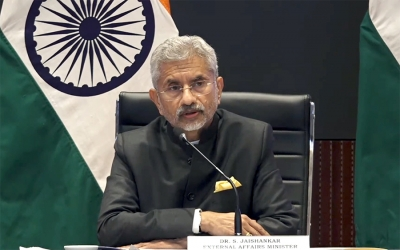New Delhi: The recent developments in the Red Sea reflected the fragility of existing connectivity link and it reinforced the need to create multiple transport corridors with in-built resilience, External Affairs Minister S Jaishankar said Tuesday.
In an address at a conference, he highlighted India’s deepening relations with Europe and said the ambitious India-Middle East-Europe Economic Corridor (IMEC) would create significant opportunities for global economic growth.
Emphasising the need for creating different connectivity corridors, Jaishankar said the fragility of the existing routes were not clear when the IMEC initiative was unveiled last September.
“When this (IMEC) understanding in principle was reached last September on the sidelines of the G20, perhaps all of us were not adequately cognisant of the fragility of existing connectivity,” he said.
“Recent events in the Red Sea in the Gulf of Aden have reminded us of that,” he said at the CII-organised conference on “India and Europe: Partners in Growth and Sustainability”.
There have been mounting global concerns over Houthi militants attacking various cargo vessels in the Red Sea and other strategic waterways in the region apparently in response to Israel’s military offensive in Gaza.
“The need today is to create multiple supporting corridors of connectivity. Different ones with their own in-built resilience is something which is vital. It is vital because at either end of this, you actually have two big production and consumption centres — Europe and India,” Jaishankar said.
The IMEC is seen as an initiative by like-minded nations to gain strategic influence in the face of China’s Belt and Road Initiative (BRI) which has faced increasing criticism over lack of transparency and disregard for sovereignty of the nations.
Jaishankar said the IMEC is not the only corridor and there are others as well.
“There is a longer one which is being worked through Iran. But I also want to mention some other potential connectivity channels which would be of long-term interest to India, Europe, and India,” he said.
Jaishankar cited the India-Myanmar-Thailand trilateral highway project saying it can complement larger connectivity projects.
He also talked about the “polar route”.
“There is today a serious assumption that the polar route could actually open up a different logistical pathway between India and Europe which would go through the Indo-Pacific,” he said.
The external affairs minister also showcased the strength of the Indian economy and its future trajectory.
“Part of the reason why we need a much smoother interface between our economies is that it is important for the European Union to prepare for the India that is to come,” he said.
“And what is the India which is to come. Today India has a GDP of 3.75 trillion dollars,” he said.
The GDP by the end of the decade would be 7.3 trillion dollars.
By the year we are in the 100th year of our independence, it is estimated at USD 30 trillion and according to Goldman Sachs, by 2075 we would be at USD 52.5 trillion, he said.
“So that is an arithmetical way of saying that India would be an increasingly significant economy, the second largest by 2075 and certainly the third largest by end of this decade in national terms and that is something which the European Union has to take into account,” Jaishankar said.
PTI
